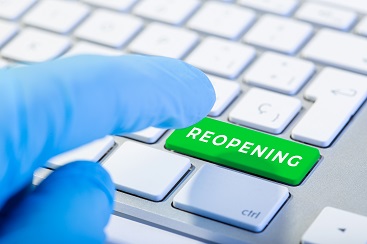
One-way corridors. Contactless elevator buttons. Wearable devices that vibrate when someone stands less than six feet away. Employees returning to their workplace for the first time since COVID-19 lockdown may encounter these changes and others. A recent Corporate Wellness article outlined modifications businesses can make to foster social distancing and limit disease transmission.
Many suggested adaptations rely on automation to limit contact, making technology the new co-worker.
Health Monitoring at the Door
The most reassuring sign of an employer’s concern for workers’ safety is regular health monitoring. The WHO has advised employers to conduct regular health checks like symptom screening and temperature checks to identify high-risk workers. Mobile Health’s COVID-19 screening and testing program delivers these health checks and others on-site to businesses, schools and live events. The occupational health provider can quickly mobilize to provide one-time or regular symptom monitoring, temperature screening, COVID-19 testing and a results dashboard.
Beyond health checks, employers also have retooled work policies to support telework and/or staggered or hybrid schedules and to isolate exposed or infected employees. Consequently, even with workers back at their desks, video likely will supplant in-person hiring and meetings.
The Remodeled Office
Who’s headed back to work? According to the Kastle Back to Work Barometer, a weekly report of building access activity, occupancy rates of Dallas and Houston offices hover around 40 percent. Conversely, the New York and Philadelphia metro areas have held steady at 17.4 and 28.8 percent occupancy rates, respectively. However, fall spikes in COVID-19 cases could impact these trends.
Post-COVID workplaces that do reopen likely will have adopted short- and long-term measures designed to keep returning employees safe, healthy and productive. These changes include the following:
- Workstations spaced at least six feet apart, with large ‘Xs’ between them to indicate off-limit areas.
- Posters and signage instructing employees to walk around their office clockwise and stick to one side of the corridors or stairs.
- Installation of transparent physical barriers to shield employees from one another, and receptionists from visitors and clients.
- Creation of a contactless office to limit contact with infected surfaces — elevator buttons, door handles, light switches, even the break room coffee machine. Smartphone technology, motion sensors and face and voice recognition can be employed to enable a “hands-off” office.
- In lieu of high-tech solutions, consider installing hand sanitizer dispensers by each door for immediate sanitizing.
- Regular cleaning and disinfection of items where contact is unavoidable, like work desks, laptops, telephones, keyboards, and chairs.
- Eliminating poor ventilation, fequently the culprit behind virus transmission. When possible, install high-efficiency air filters in shared office spaces that filter coronavirus particles and dirt without limiting airflow. Natural ventilation, opening windows wherever possible and when it is safe to do so, provides a lower cost alternative.
Make Mobile Health Your Trusted Testing Partner
As a longtime provider of screening and testing for communicable diseases, Mobile Health understands the challenges and risks associated with returning staff to the post-COVID workplace. We already provide COVID-19 screening and testing for a wide range of businesses, schools and events. Our team of experts will answer your questions and help you design a comprehensive solution. Contact Mobile Health today for a free COVID-19 Testing consultation.
Tags: contactless office, COVID-19 testing, post-COVID workplace, Return to Work

